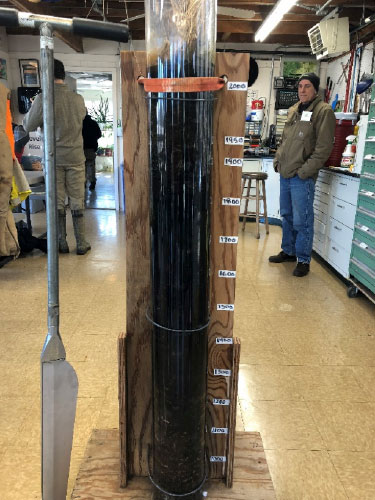By Stefanie Simpson, Blue Carbon Program Senior Manager, Restore America’s Estuaries
 Coastal wetlands – marsh, mangroves, and seagrass – are some of the MOST productive ecosystems on the planet. They provide critical habitat for many important finfish and shellfish that we fish for and eat; they improve our water quality by filtering out pollutants and excess nutrients; they protect our coast line from storms, providing wind and wave buffer; and now we know they also have an important role to play in mitigating climate change – also called BLUE CARBON.
Coastal wetlands – marsh, mangroves, and seagrass – are some of the MOST productive ecosystems on the planet. They provide critical habitat for many important finfish and shellfish that we fish for and eat; they improve our water quality by filtering out pollutants and excess nutrients; they protect our coast line from storms, providing wind and wave buffer; and now we know they also have an important role to play in mitigating climate change – also called BLUE CARBON.
Blue Carbon refers to the greenhouse gases that are capture by, stored in, and released by coastal and marine ecosystems. At Restore America’s Estuaries, we are interested in blue carbon as a way to add value to coastal wetland restoration efforts and bring new partners to the table to support these efforts, so I was thrilled when invited to speak about blue carbon at Scotts Miracle-Gro Foundation’s recent National Partner Network meeting.
Why do I get so excited to talk about Blue Carbon? Most people don’t realize that coastal wetlands are extremely good at capturing and storing carbon in the ground long-term. In fact many coastal wetlands are capturing and storing carbon at rates up to 10 times more than forests on a per area basis!
 In 2016, RAE led a study in Tampa Bay, Florida, with support from our partners at ScottsMiracle-Gro, to find out how much carbon would be captured by Tampa Bay coastal wetlands over the next 100 years. The study found that some of the existing habitats in the region may transition to new wetland types as sea level increases. For example, marsh habitat that may drown out could be replaced with seagrass habitat expanding into these newly flooded areas. Scotts Miracle-Gro is working with many partners as part of regional efforts in Florida to maintain water quality, which is important for thriving seagrass habitat.
In 2016, RAE led a study in Tampa Bay, Florida, with support from our partners at ScottsMiracle-Gro, to find out how much carbon would be captured by Tampa Bay coastal wetlands over the next 100 years. The study found that some of the existing habitats in the region may transition to new wetland types as sea level increases. For example, marsh habitat that may drown out could be replaced with seagrass habitat expanding into these newly flooded areas. Scotts Miracle-Gro is working with many partners as part of regional efforts in Florida to maintain water quality, which is important for thriving seagrass habitat.
Although some of these habitats are likely to change over the next 100 years, they will continue to capture and store carbon. By the year 2100, Tampa Bay coastal habitats are estimated to capture and store 3.5 million tons of CO2, offsetting the burning of 400 million gallons of gasoline!
Why are wetlands so good at capturing carbon? Because they are constantly wet, the soil is low in oxygen, which slows down decomposition. So as wetland plants capture carbon through photosynthesis and accumulate dead plant materials, these carbon-rich soils slowly build up over time. Coastal wetlands can have hundreds or even thousands of years of carbon buried beneath them!

From carbon capture to water quality, these amazing habitats provide so many benefits! Unfortunately, coastal wetlands also face an increasing number of threats. As Restore America’s Estuaries seeks to protect these vital places, we strongly believe that partnerships are essential to our success. The recent National Partner Network meeting hosted by ScottsMiracle-Gro Foundation reinforced this idea, and planted the seeds for future collaborations. By working together, we can achieve a greener, cleaner planet!

